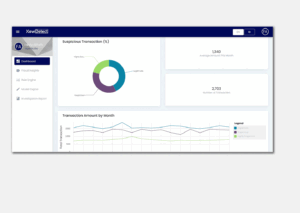4 Innovative Safeguards: Technology’s Role in Anti-Money Laundering for Insurance
In the dynamic landscape of insurance, combating the pervasive threat of money laundering is a multifaceted challenge. As the regulatory landscape evolves and financial crimes become increasingly sophisticated, the need for proactive measures becomes more urgent. Before we delve into four innovative safeguards, let’s address three critical challenges faced by the industry in its ongoing battle against financial crimes:
-
-
Spotting Insurance Money Laundering in External Dealings
Money laundering involving external entities, like partners and customers, is a real risk. Deceptive practices, such as manipulating referrals or submitting false claims, can lead to financial losses and harm the reputation of insurance companies. This is a continuous problem that needs regular monitoring and smart solutions. Investigations into Russian money laundering scandals uncovered that major insurance firms, including state-owned Rosgosstrakh, allegedly funneled over 50 billion rubles ($1.6 billion) offshore between 2006 and 2009 using hundreds of shell companies and fake contracts, disguising these funds through external consulting and securities transactions.
-
-
-
Agents and Money Laundering
Agents getting involved in insurance money laundering adds another layer of complexity. Agents seeking personal gains may use tactics like forging documents or promoting policies that facilitate money laundering. This issue goes beyond economic downturns, so we need ongoing efforts to make sure agents follow ethical practices and keep the insurance sector’s integrity intact. Japan Post Insurance had engaged in 90,000 cases of inappropriate sales to their customers over a five-year span in 2019 which mainly due to the disqualifying insurance agents.
-
Insurance Money Laundering Risks in Business Conduct
Insurance money laundering risks are not limited to external dealings. It is also known as one type of misconduct which involving suspected breaches or circumvention of business conduct rules when carrying out financial services activities. One of the examples for misconduct cases related to conduct of business was acted by Prudential. In 2019, the Financial Conduct Authority (FCA) has fined Prudential £23,875,000 for selling retirement income products without informing customers if better rates could be found elsewhere and failed to take reasonable care to organise and control its affairs in breach of its obligation to ensure fair treatment of customers. Another example of misonduct in Malaysia insurance sector highlighted the importance in adopting real-time screening or monitoring mechanism. The central banks of Malaysia (BNM) imposed an Administrative Monetary Penalty of RM260,000 on MPI Generali Insurans Berhad for a breach in real-time screening protocols due to the onboarding delay of a sanctioned person
-
Now, armed with an understanding of these challenges, let’s explore four innovative safeguards that leverage technology’s crucial role in fortifying the insurance industry’s defenses against the ever-evolving landscape of money laundering.
4 Innovative Safeguards in Countering Money Laundering
1. Enriching Data with AI Tools: Beyond the Surface Detection
Traditional methods of detecting money laundering often fall short in the face of evolving tactics. Enter artificial intelligence (AI), a game-changer in data analysis. By enriching data from diverse sources, AI tools transcend surface-level detection and provide real-time insights in identifying nuanced patterns and anomalies, that might otherwise go unnoticed. This innovative approach ensures a comprehensive view, enhancing the accuracy and efficiency of insurance anti-money laundering efforts.
2. “Connecting the Dots” with Knowledge Graph: Unraveling Complex Money Trails
Money laundering schemes often involve intricate webs of transactions and relationships. Knowledge Graph technology acts as a virtual detective, connecting the dots and unraveling complex money trails. By analyzing relationships between entities, this innovation provides deeper insights, expediting investigations and empowering insurers to stay one step ahead of increasingly sophisticated financial crimes.
3. NLP for Deeper Insights: Understanding the Language of Financial Transactions
In the realm of insurance anti-money laundering, communication is key. Natural Language Processing (NLP) proves indispensable in understanding the language of financial transactions. From emails to social media interactions, NLP helps insurers gain deeper insights, identify red flags, and classify interactions with a level of nuance that traditional methods often overlook. This innovative safeguard equips insurers with a heightened ability to detect potential money laundering activities.
4. Predictive ML Models with Cognitive Engines: Anticipating and Mitigating Risks
In the ever-evolving landscape of financial crimes, anticipation is the linchpin of effective risk management. Predictive machine learning models, complemented by cognitive engines, empower insurers to anticipate and mitigate risks proactively. By processing vast datasets and identifying patterns indicative of potential money laundering, these models provide actionable insights, ensuring a forward-thinking approach to risk mitigation.

Embracing Innovation for Robust Anti-Money Laundering Practices
As the insurance sector confronts the relentless challenge of money laundering, these four innovative safeguards underscore the pivotal role of technology. Embracing AI, Knowledge Graph technology, NLP, and predictive machine learning models propels insurers into a new era of anti-money laundering practices. By staying at the forefront of technological innovation, the industry not only fortifies its defenses but also contributes to the collective resilience against financial crimes.
Check out more that might give you a hint:













